Combination Cancer Immunotherapy — A Virtual Roundtable: Part IV

By Wayne Koberstein, Executive Editor, Life Science Leader
Follow Me On Twitter @WayneKoberstein
Llew Keltner, M.D., Ph.D., Roundtable Moderator
A series on the challenges and opportunities of using new agents to rally the immune system against cancer.
PART FOUR: Companies At Stake, Catching Up, And Competing

Why have some of the biggest companies in cancer immunotherapy shied away from this roundtable discussion? Why have others joined in? And why do so many companies, small to large, want to take part in this forum? In addition to a dozen key opinion leaders (KOLs) featured in the first two parts of this series which began in September, twice as many companies responded to our call. Now, after publishing Part Four here, we will still have at least ten more company responses to run in the coming months, with even more responders wanting to jump on board before the end — having seen their peers and rivals speaking through this report.
There is a parallel explanation for the number of responses the roundtable has attracted: KOLs and companies have many ideas about cancer immunotherapies and how they may be used in combinations. In certain cases, someone’s definition of immunotherapy excludes another’s approach; for example, those who champion the new checkpoint-inhibitor or co-stimulation therapies which target the immune system, not the cancer, may refuse to acknowledge any form of tumor-targeting strategy as immunotherapy. Moreover, many believe tumor heterogeneity and adaptability doom tumor-targeting to an ultimate dead end. But others consider traditional chemo, hormone therapies, and tumor-targeting drugs as ready candidates for immunotherapy combinations. This roundtable encompasses both sides of that debate and more.
QUESTIONS VERBATIM
This month’s installment of the Combination Cancer Immunotherapy roundtable continues the presentation of responses to questions we sent to the leaders of companies that aspire to play a role in this exciting field. We did our best to invite and include all of the companies now developing cancer immunotherapies, chiefly in the new areas generating the most excitement in the oncology community: checkpoint inhibitors and co-stimulators and complementary immunostimulators such as cancer vaccines and ablative modalities that promote immune-cell production. We also heard from a few companies that believe other approaches deserve a place among the possible cancer immunotherapy combinations the roundtable addresses.
The questions we asked the panelists were as follows:
Why combinations?
Do you believe cancer immunotherapies should be used in combinations rather than as single agents or is it possible to envision a single effective immunotherapeutic agent?
Essential components?
In your opinion, if cancer immunotherapy combinations are essential, what are the essential constituents of any combination therapy?
Backbone therapy?
Will a particular approach such as PD-1/PD-L1 be the “backbone” of cancer immunotherapy combinations? Or will consensus on a hierarchy of therapies continue to evolve with the growth of scientific understanding in ongoing research?
Combo criteria?
By what criteria will physicians select specific immunotherapy combinations for individual patients or patient groups? Or will regulatory and reimbursement realities dictate the combinations?
Narrow or wide applications?
Will the most effective immunotherapy combinations be specific to traditional cancer indications (NSCLC [Nonsmall cell lung cancer], HCC [Hepatocellular carcinoma], etc.) or tend to have general effectiveness against all or a wide range of cancers?
Personal or broad?
Do you see limits on the practice model for cancer immunotherapies; i.e., will cellbased approaches remain restricted to a small number of patients in intensivecare or salvage settings?
Commercialization challenges?
What are some of the major hurdles you face in commercializing your cancer immunotherapy product or products, especially considering that the science, regulatory pathway, and market are still evolving?
General comment?
Is there anything else that you believe is critical to understanding how combination immunotherapy or another immunotherapeutic approach will move into use as the backbone of cancer therapy?
At this point, reading the previous installments in this series is essential to understanding its mission, organization, and context. (See also “Questions Verbatim.”) So, in the interest of using this space efficiently, we hereby continue our companies’ responses in this, Part Four of “Combination Cancer Immunotherapy — A Virtual Roundtable.”
(MORE) COMPANY LEADERS RESPOND
The following are the responses:
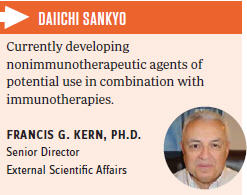 Why combinations?
Why combinations?
The promise of PD-1 (programmed cell death protein 1) and PD-L1 (programmed death-ligand 1) antibodies in demonstrating the ability to elicit deep and durable responses as monotherapies in a number of indications suggests that, in many instances, a single agent may be sufficient. However, the combination of ipilimumab (Yervoy) and nivolumab tested in clinical trials for melanoma also demonstrated that the same type of benefit may be extended if the right agents are utilized. At present, though, we have little understanding of biomarkers that can be efficiently utilized to determine when a combination will be needed and when it will not. With the added toxicity that is likely to result from some of these combinations, it will be important to begin to sort this out.
Essential components?
The increased rate of grade 3 and grade 4 toxicities seen with the ipilimumab and nivolumab combination in melanoma was balanced by the greatly increased response rate and the clinical experience developed in effectively managing these toxicities. In the near future, we are likely to hear about how applicable this particular combination is in other settings. We should also soon learn about the initial results of other combinations that companies with PD-1 and PD-L1 antibodies are trying with other immunotherapy assets in their own armamentarium or in collaboration with other pharmas and biotechs. Obviously, any increase in toxicity or autoimmune-related adverse events with these new combinations must also be sufficiently balanced by increased efficacy and clinical understanding of how to manage these events.
Backbone therapy?
Certainly the relative safety and extent of efficacy seen with the PD-1 and PD-L1 antibodies in early clinical trials warrants the major ongoing effort to identify the most appropriate combination partners. The increased efficacy seen in clinical studies with the addition of ipilimumab to treat melanoma demonstrates the endeavor is likely to succeed in at least some cases. However, it is still unclear if the lack of efficacy in some nonresponding patients is due to the absence of this particular checkpoint inhibitor system functioning in those particular patients. We know that there is a large number of related molecules postulated to have similar inhibitory effects on T-cell function. It would not be too surprising to eventually find that some of these may be working where the PD-1/PD-L1 antibodies are not.
Combo criteria?
In the near term at least, the old standbys of efficacy and safety will likely dictate which combinations physicians will choose to use. If deep and durable responses occur with these combinations, it should be apparent to payers that they may obviate the need for subsequent second and third lines of therapy and their accompanying supportive care costs. Therefore, the expense associated with two biologics may be justified by the curative potential.
Personal or broad?
Clinical studies have shown remarkably deep and durable responses with CAR (chimeric antigen receptor) T-cell approaches in relapsed and refractory leukemias and in some lymphomas. But cellbased approaches also require intensive, supportive clinical care and are presently associated with a very high cost of goods and may not be compatible with a pharma’s business model. The same factors also currently apply to other engineered T-cell receptor approaches that might be able to show more utility for solid tumors. The large numbers of engineered T cells currently required for both CAR T- and exogenous TCR (T cell receptor)-based approaches remain an obstacle to the expanded use of these cell-based therapies. However, progress is being made in identifying and selecting the most appropriate T-cell subtypes for use as recipients for the vectors, which could significantly reduce the cost of goods. Lack of identification and validation of cancer-specific targets also impedes the safe extension of these approaches to solid tumors.
Off-the-shelf immunotherapy agents may still require predictive biomarkers and can therefore still be considered as “personalized medicines” but not to the same extent as the current cell-based therapies. In contrast, off-the-shelf cancer vaccines have not delivered the same type of response rates as the antibodies but could eventually prove their utility in combination with immune checkpoint inhibitors, co-stimulators, or other immunomodulatory agents. In fact, some sort of vaccination-type approach may be required for the other immunotherapies to exert their full effects. There is also data that indicate that an immune response to the tumor needs to pre-exist in the patient for checkpoint inhibitors to be effective. It doesn’t matter if you remove your foot from the brake or step on the gas if the car isn’t running.
Commercialization challenges?
Daiichi Sankyo is not currently running clinical trials with immunotherapy agents, but we believe we have some agents in our pipeline that might be active as a part of an immunotherapy combination. Because it seems there are so many combinations that would make sense to try, we need to generate sufficient interest among potential partners for using our pipeline agents in combination with theirs. We are now making good progress on that front as we generate more preclinical and clinical data supporting the rationale.
When we start getting into three or four agents and an aging population seeking these combinations in greater numbers, something will have to give. It is unlikely that a single company will have exclusive rights to all of the combination partners, and the market value of their particular agent may in many cases be coming exclusively from the synergy seen from use in combination. It seems likely then that pricing will be affected and reimbursement for use will be less than the sum of prices seen with current biologics used as single agents. Partnering companies should be willing to accept this as a price for having a piece of the action.
General comment?
Better preclinical models need to be developed to allow us to predict the efficacy and safety of the various possible combinations. There are already too many combinations to test efficiently in the clinic, and this number is likely to grow to an even greater extent as we get a better understanding of the role of some of the emerging targets and identify new targets.
 Why combinations?
Why combinations?
We support a combination approach for the obvious reason that single-agent immune therapeutics still do cure cancer for the majority of the treated patients. A combination approach has already been proven more efficacious in several advanced-stage clinical studies (e.g., ipilimumab and nivolumab for melanoma; pidilizumab and rituximab for lymphoma). Further support for this rationale is widely provided in experimental tumor models.
Essential components?
Essential constituents would be immuneenhancing reagents and/or tumor-targeting reagents (ADCC [antibody-dependent cellmediated cytotoxicity] or direct cytotoxic conjugates) and checkpoint inhibitors.
Backbone therapy?
With a level of ORR (overall response rate) of 30 to 40 percent using the PD-1/PD-L1 blockade, this approach could be considered at this time a backbone of cancer immunotherapy combinations, yet once more data is generated in the clinic, we estimate that a hierarchy of therapies will continue to evolve with the growth of scientific understanding.
RINAT ROTEM-YEHUDAR, PH.D.
Vice President, Research and Development Curetech
Combo criteria?
Will physicians select specific immunotherapy combinations for individual patients or patient groups based on medical evidence and judgment? Or will regulatory, formulary, and reimbursement realities dictate the combinations? It’s a combination of both, I’m afraid. In an ideal world, the criteria would consider the specific indication, the subject’s genomic/protein profile, and off-the-shelf SOC (standard-of-care) approved for this subject population. The SOC would probably be constituted of multireagent protocols — immune-enhancing reagents, tumor-specific vaccines, tumor-targeting reagents (mAbs using ADCC or direct cytotoxic conjugates), and checkpoint inhibitors, as well as other approaches such as mutation-targeting small molecules.
Personal or broad?
We do not see the two options as mutually exclusive; namely, we do not exclude the possibility of using a combination of patient cell-based approaches with checkpoint inhibitors. Obviously, the limits on customized cell-based therapy may render this approach less practical or cost-effective.
Commercialization challenges?
Collaboration/cooperation among companies and between companies and regulators should be better facilitated to bring optimal combo protocols to the market and maximize patient benefit.
General comment?
We need a governmental budget and regulatory path to support and expedite a global effort to map and optimize multireagent combo protocols with existing and investigational therapeutics.
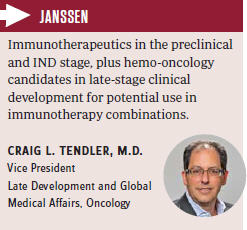 Why combinations?
Why combinations?
We agree that immunotherapy is certainly going to be a cornerstone of cancer treatment. Initially, of course, most of the data is for solid tumors, but we believe there is also an excellent opportunity in the hematologic malignancy space. We have specific immunotherapy strategies for each of our three major disease areas of interest — prostate cancer, heme malignancies, and lung cancer — where we’re looking for the best targets that could synergize with other drugs we have in those spaces. Some of the single immunotherapy agents can deliver durable remissions in a small subset of patients, whereas targeted agents may be active in a larger proportion of patients but have short durations of remission. This would provide a strong rationale to combine immunotherapy and targeted therapies in the hope that we can substantially increase the percentage of patients achieving durable remissions and prolong survival without a substantial increase in toxicity. We are also looking at strategies to block multiple negative immune checkpoint pathways on T cells or agonize stimulatory checkpoint pathways in parallel, as some of these checkpoint pathways may become more active and mediate resistance when a PD-1 inhibitor is used as monotherapy.
Essential components?
The essential components include exceptional biologics expertise, synergy with internal (small molecules) and external platforms, and disease area-focused strategies with potential for cancer interception. We also need a lot of comparative studies to test add-on study designs, and many of the companies that have drugs in this space are already doing them. Also, who are the patients most likely to respond to immunotherapy? Do they have high levels of PD-1 and infiltrating T cells in their tumors? A personalized medicine approach to immunotherapy is also likely to be a key success factor. Finally, it will be very important to study the responding patients over time to see what happens when they relapse. Is it that some of the other proteins become activated and they are not blocking them? What drives rational combinations is understanding what happens during disease progression.
Backbone therapy?
There are 10 checkpoint proteins at least, so it would be short-sighted to believe that a single therapy would dominate. We need to understand what happens to the other proteins when you inhibit one and to learn from that in building rational combinations. We are also trying to look at immunotherapy beyond what we call the T-reg space and prime antitumor immunity using bispecific monoclonal antibodies optimized for T-cell recruitment to tumor antigens. Such bispecific antibodies can mediate highly potent, but selective, immune cell killing of tumors.
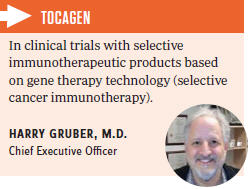 Why combinations?
Why combinations?
It is likely any effective immunotherapy will require several diverse mechanisms of action (MOAs). Whether that will be through what is considered a single agent or a combinatorial approach remains to be determined.
Essential components?
MOAs must break tumor tolerance — boosting the immune system, tumor killing, antigen presentation, expansion of TAA-reactive immune cells, reduction of immuno-suppressive cells in the tumor, or other approaches, depending on the potency and mechanism included in a particular therapy. Selecting the right combination of mechanisms will depend on how the cancer has evolved to evade the immune system and how a particular patient’s immune system is structured. Selective killing of cancer while sparing normal tissue and avoiding autoimmunity is the goal of immunotherapies, single or in combination. Our product candidates are designed to activate the immune system selectively to kill cancer cells.
Backbone therapy?
Immune checkpoint inhibitors are likely to play an important role in the hierarchy of combinations, but it remains to be seen how effective and durable they will be across the whole cancer landscape. Also, it should be noted that immunotherapies including PD-1/PD-L1 approaches may face challenges with autoimmunity, which could limit their use. Systemic delivery of PD-1 inhibitors will affect both normal cells and cancer cells and therefore disrupt normal T-cell regulation, resulting in potential autoimmunity.
Combo criteria?
Today we accept efficacy as the most important outcome of cancer treatment. As cancer begins to be conquered, but with a cost of very serious side effects or meaningful inconveniences, safety and tolerability along with efficacy will become the dominant requirements for the most commercially successful treatments.
Narrow or wide applications?
Patient-specific cancer therapy is being routinely used today, and now matching proper immunotherapies to the patient’s immune status as well as tumor environment will be key to the success of each therapy. Platforms that are amenable to surgical, chemo-, radio-, and immunotherapeutic combinations have the potential for multiple routes of administrations, are well-tolerated, and will lead to cancer immunotherapeutic drugs with the greatest chance of success across multiple indications.
Personal or broad?
Both approaches, personalized and broad spectrum, should be explored. The armamentarium oncologists will need to outwit the cancer must be larger and more powerful than those the cancer has developed to attack the immune system. The most successful products will activate the immune system selectively against the cancer, ideally tricking the tumor into becoming a factory that generates immune-related components and destroys itself.
Commercialization challenges?
Companies that want to be relevant in this extremely fast-moving industry need to be completely dedicated to leveraging this amazingly unique opportunity in the history of the war on cancer. Staying focused on the battle at hand is the most important and difficult task. Recruiting and motivating a moderate-sized team of highly passionate and driven individuals is always hard but typically the path to success.
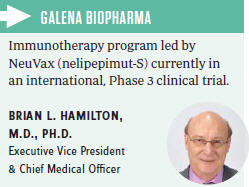 Why combinations?
Why combinations?
It is possible for a single immunotherapeutic antigen to elicit a robust and effective immune response, depending on the intrinsic immunogenicity of the antigen and the related sensitivity of the target tumor cells. Combining a peptide antigen with the addition of immunoadjuvants, immunomodulators, or checkpoint inhibitors may boost the immune response of most antigens.
The effectiveness of a cancer immunotherapy depends on multiple factors. The immune response is a function of the immunogenicity of the antigen, the route of antigen administration, and the relative responses of cytotoxic T cells, T helper, and T regulatory cells to the antigen. The ability of the immune response to destroy tumor cells is a function of the density of antigens on the target tumor, the sensitivity of the target tumor cells to immune destruction, and the patient’s tumor burden. The stage of the patient’s disease, including the level of tumor burden, also has a big impact on the effectiveness of the immunotherapy, as tumor micro-environments are known to have a significant effect on immunogenicity of the mass.
Essential components?
The specific adjuvants and modulators added in combination with the antigen will likely be antigen-specific and identified empirically for each antigen. The selection of the approach to take and the specific adjuvants or immunomodulators used may be guided by an assessment of the initial immune response. Antigen processing may be enhanced by the addition of GM-CSF (granulocyte-macrophage colony-stimulating factor) to mature dendritic and other antigen-processing cells. An excessive T-regulatory cell response could be decreased by adding checkpoint inhibitors or low-dose cyclophosphamide.
Backbone therapy?
The immunogenicity of each specific antigen, the repertoire of immune responses elicited, and the range of sensitivity among the target tumors suggest there will not be a “one size fits all” approach. The requirement for additional adjuvants, checkpoint inhibitors, or other immunomodulators must be determined empirically for each immunotherapy and possibility for each stage of disease. Immunotherapy may be more effective in specific settings when combined with targeted chemotherapeutic agents. Improvements in the immunotherapy of cancers will depend on the ever-increasing scientific understanding of the immune response from ongoing basic and clinical research.
Combo criteria?
The selection of immunotherapy for patients will depend primarily on the evidence that this approach will benefit patients and their side-effect profile, along with the cost of the therapy and the reimbursement of the treatment by third-party payers. The specific choice of the immunotherapy, including the patient populations and the addition of immunoadjuvants and/or immunomodulators, will be guided by the combination’s scientific rationale and by regulatory input. With NeuVax, an HER2 (human epidermal growth factor receptor 2) immunodominant peptide vaccine, the addition of the monoclonal HER2 antibody, trastuzumab, may facilitate the antigen processing of the vaccine peptide and provide a second effector mechanism to potentiate the killing of HER2-expressing tumor cells by cytolytic T cells. Checkpoint inhibitors tend to have significant side-effects, and the use of these agents in minimal disease settings, such as the adjuvant setting, may not be appropriate for this class.
Personal or broad?
Although cell-based immunotherapy has the advantage of boosting the immune response to the patient’s individual tumor-associated antigens, the technical complexities and cost will limit the number of patients who will be treated and receive benefit from this approach. The relative simplicity of more general immunotherapy approaches such as peptidebased vaccines would apply to a larger number of patients who could be treated and receive benefits and would be less expensive than the cell-based approaches.
The complexity of cell-based immunotherapeutic approaches will continue to restrict their use to a small number of patients. As with any immunotherapy, cell-based approaches would best be used in minimal residual disease settings such as neoadjuvant and adjuvant treatments. Conversely, late-stage, bulky tumors in the salvage setting would be more aggressive and less sensitive to destruction by the immune response.
Commercialization challenges?
The major hurdles to developing and commercializing cancer immunotherapies include the prolonged development times; the complexities of optimizing the combinations of antigens, adjuvants, and immunomodulators; and the immunization schedules to optimize the effectiveness of this approach (cancer immunotherapy) to cancer therapy.
Preventing disease recurrence is an ideal setting for cancer immunotherapy and attractive for patients and payers. Galena Biopharma is developing innovative peptide vaccine cancer immunotherapies that address major patient populations of cancer survivors to prevent recurrence. These therapies work by harnessing the patient’s own immune system to seek out and attack any residual cancer cells. The approach of using peptide immunogens has many clinical advantages, such as a well-tolerated safety profile, long-lasting protection through immune system activation, and convenient delivery. NeuVax is easy to administer because it is given as an intradermal injection once a month for six months, followed by a booster injection once every six months.
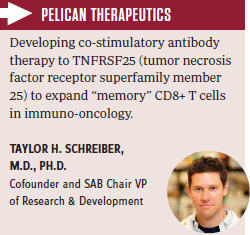 Why combinations?
Why combinations?
For some patients, single-agent therapeutic blockade of CTLA-4 (cytotoxic T-lymphocyte-associated protein 4) or PD-1 appears to be an effective approach that can facilitate long-term survival even in late-stage disease. For both strategies, however, clinical benefit is unfortunately observed only in a minority of patients, even in a highly immunogenic tumor such as melanoma. Thus, it is highly likely that combinations among several immunotherapeutic and/or conventional modalities will provide synergistic benefit for patients.
Essential components?
The essential constituent of any combination therapy is a solid understanding of the mechanism of action of each individual agent. Short term, most combinations will likely include a CTLA-4 or PD-1/ L1 blocking antibody. To expand the base of patients responding to checkpointblockade monotherapy, there are three obvious choices for combination: other checkpoint-blocking antibodies, vaccines, and T-cell co-stimulatory antibodies. Combinations with other checkpointblocking antibodies may extend responses to include patients where PD-1 or CTLA-4 are either not the dominant or are a co-dominant source of tumor-mediated immunosuppression. Combinations with vaccines are likely to expand the repertoire of tumor-specific T cells that may more effectively proliferate and kill tumor cells when a checkpoint inhibitor is on board. Finally, combinations with T-cell co-stimulatory antibodies will likely provide enhanced proliferation and effector function of pre-existing, tumor-specific T cells to overcome resistance to other sources of immunosuppression.
Backbone therapy?
For the next several years, checkpoint-blocking antibody therapies are likely to remain the backbone of combination therapies. These therapies have had the earliest FDA approvals and will continue to have approvals with other agents and in new indications for several years. Approved agents are more readily available as combinations in new clinical protocols and, if effective, will remain on the label for subsequent approved combination modalities. Other indications may become the testing ground for noncheckpoint inhibitor-based combinations.
Backbone therapy?
For the next several years, checkpointblocking antibody therapies are likely to remain the backbone of combination therapies. These therapies have had the earliest FDA approvals and will continue to have approvals with other agents and in new indications for several years. Approved agents are more readily available as combinations in new clinical protocols and, if effective, will remain on the label for subsequent approved combination modalities. Other indications may become the testing ground for noncheckpoint inhibitor-based combinations.
Combo criteria?
Physicians will likely opt to participate in clinical trials where combination modalities are based on solid preclinical data supportive of mechanistic synergy. Combination treatments using approved indications can, and should, be based upon superior efficacy of certain regimens over others on the basis of randomized controlled trials. It remains to be seen how the pricing of specific combinations will be set by the drug providers and how physicians (vis-à-vis insurers) will respond.
Personal or broad?
Allogeneic cell-based vaccine approaches have an outstanding safety record, and there is no reason to believe that their implementation should be limited to patients with late-stage disease. Indeed, this is the setting where vaccines are most likely to succeed only in combination with other modalities. Vaccine monotherapy is a very attractive approach for patients with minimal residual disease to “mopup” microscopic lesions and prevent recurrence.
CAR T-cell therapies will likely remain a strategy for hospitalized patients. Even in the limited numbers of patients treated so far, severe side effects were common and required patient management in the intensive care setting, mainly due to tumor lysis syndrome but also other inflammatory sequellae. Other long-term concerns will eventually surface, due mainly to the risk for off-target T-cell activation.
Patient-derived autologous vaccines have always held the promise of being an effective strategy because the final vaccine composition is more likely than an off-the-shelf vaccine to contain a repertoire of antigens matching the patient’s tumor. Unfortunately, commercialization of such vaccines has stalled because manufacturing cost and complexity have not been scalable.
The more recent development of autologous chimeric antigen-receptor transfected T-cell therapies and tumorinfiltrating lymphocyte therapies offers new hope for autologous-based therapies. Although they have not yet been successful in solid tumors, their early record in some hematologic malignancies is impressive and likely to reach broader utility in the near future.
CRAIG L. TENDLER, M.D.
Vice President, Late Development and Global Medical Affairs, Oncology Janssen
Commercialization challenges?
Current excitement over cancer immunotherapy has driven significant investment in promising new treatments. The FDA has demonstrated a willingness to consider novel-novel drug combinations provided that the early safety monitoring of treated patients is rigorous. In many immunotherapy trials, there seem to be responders and nonresponders for specific agents. Developing prognostic markers for responders is a complicated task, but markers may ultimately identify patient-specific treatment regimens without the need for patient-specific therapeutics. This will not only facilitate the approval of new combinations but also may link combinations to patient subsets for maximum safety and efficacy.
General comments?
There are three “elephants in the room” for the emerging field of cancer immunotherapy: 1) What combinations make sense? 2) What combinations have an acceptable toxicity/benefit profile? 3) Who will pay for expensive combinations? Some extremely innovative work is taking place to address each of these questions, and the results are likely to shape the eventual cancer immunotherapy market in currently unpredictable ways. It is relatively straightforward to design experiments that decide what the right combinations might be, but developing methods to merge combinations into single-drug compositions or to limit the activity of those agents to specific anatomical sites will be an interesting story to follow.
As in Part Three last month, we have run as many company responses as space allows this month and will follow with the remainder next month and beyond if needed to explore this rich vein of lessons in translational R&D, business development, scale-up, and commercialization of breakthrough medicines. We are still open to hearing from companies that either missed our first invitation or believe they belong in the conversation. Also, join the discussion on Twitter at #CCIRLSL.
